A Study on the Coordination of Urban Traffic Control and Traffic Assignment
Abstract
The interactions between signal setting and traffic assignment can directly affect the urban road network efficiency. In order to improve the coordination of signal setting with traffic assignment, this paper created a traffic control algorithm considering traffic assignment; meanwhile, the link impedance function and the route choice function were introduced into this paper to study the user′s route choice and the road network flow distribution. Then based on the above research, we created a system utility value model. Finally through the VISSIM software to simulate the test network, we verified the superiority of the coordination algorithm and the model and gave the optimal flow of the road network.
1. Introduction
In urban transportation systems, the equilibrium of the road network supply and demand is an important problem, which can directly impact the road network efficiency. For a fixed road structure and traffic flow, signal setting is the primary influencing factor to traffic supply, and traffic assignment is the primary influencing factor to traffic demand [1, 2]. In order to balance the traffic demand and supply of urban road network and maximize the efficiency of transportation resources, experts and scholars from allover the world have done a lot of research and made great progress in the coordination of signal setting with traffic assignment aspects.
Firstly, Allsop [3] and Gartner [4] researched the relationship between signal setting and traffic assignment, and held that signal setting strategy can directly affect user’s route choice and traffic flow distribution. Then they proposed a solution program to traffic equilibrium problem by alternately updating green split signal settings for fixed flows. On these bases, in order to achieve the global optimization, Tan et al. [5] and Smith [6, 7] converted the signal setting and traffic assignment into a hybrid optimization problem. Their research showed that in some actual situation traffic setting even had deteriorated travel time by 30%; thus, they proposed a new signal setting policy under the constraint of stable traffic supply and traffic demand. Subsequently, Gartner et al. [8] and Fisk [9] proposed that we may take the signal setting and traffic assignment as a game problem of Stackberg, which regards traffic managers as superior decision-makers and travelers as subordinate decision-makers. Then, Yang and Yagar [10] proposed a bilevel programming model based on the above method; the model indicated that we can get queuing delay of saturated sections by the network equilibrium parameters instead of conventional delay calculation formula.
Since some traffic control systems and algorithms often require the real-time traffic flow distributed information to make traffic management strategy, Gartner et al. [11, 12] presented a combined framework about the real-time signal setting and traffic assignment, which can make appropriate dynamic control strategies and avoid traffic congestion according to dynamic traffic assignment model. With the research continued, Lee and Machemehl [13] studied the stochastic heuristic algorithms in coordination with signal setting and traffic assignment and applied the genetic algorithms in it. Chen and Ben-Akiva [14] regarded dynamic traffic control and traffic assignment as a noncooperation game problem; we could get the optimal signal setting and traffic assignment by iteration.
In recent years, many new methods emerged on the study of signal setting and traffic assignment relationship, for example, Chiou [15] introduced derivative information of the signal control variables into the TRANSYT system and then estimated the average vehicle delay in the road network based on sensitivity algorithm. Cipriani and Fusco [16] discussed the global optimization problem of signal setting and traffic assignment based on gradient projection method. Cascetta et al. [17] studied the optimization models and algorithms for urban signal settings with a small-scale real network based on stochastic traffic assignments. In the study of Gao et al. [18] and Chiou [19], the problem of signal setting and traffic assignment relationship was formulated as a nonlinear mathematical program with equilibrium constraints, in which the optimal signal settings were determined while trip rates and network flow are in equilibrium.
By summarizing the above research experience, this paper proposed a synergetic algorithm of dynamic signal setting and traffic assignment. In the algorithm, traffic control parameters can be updated in real time with the change of traffic demand. The basic idea of the algorithm is to change the road impedance by adjusting the split of the signal setting scheme and then cause the traffic volume transfer to realize the aim of the road network flow redistribution and the systems’ efficiency optimization. Therefore, in order to further clarify the mechanism of signal setting and traffic assignment, this paper creates a simple and practical integrated model by introducing the link impedance function and the route choice function. Finally, a system utility value calculation method is given, by which we can get the optimal flow and optimal path impedance and then compare the real flow and path impedance with the optimal flow and optimal path impedance to determine whether the road network is in equilibrium. We use the above discrimination method to optimize the efficiency of the road network.
2. Problem Formulation
Since the effects of signal control program and traffic flow are reflected in traffic participant’s travel time, we can analyze the traffic supply and traffic demand to determine the optimal flow of road network and then compare the difference between the actual travel time and the optimal travel time to discriminate whether the road network is in equilibrium.
On the basis of the above statement, two questions can be summed up from the above representations. First, a coordination algorithm of traffic demand and traffic supply should be established if you want to achieve the mutual feedback traffic control and flow distribution. Second, we should create some appropriate model about traffic control and traffic assignment to implement the algorithm.
3. Algorithm Establishments
The algorithm establishment consists of two parts in this paper: the first part of the algorithm mainly analyzes the relationship between signal setting and flow distribution. Before we establish the algorithm, a stable state of the road network flow is needed to realize the objective of traffic flow equilibrium, which means that the difference between road network inflow (qui) and road network outflow (qvi) should be less than a fixed value (ε), qui − qvi < ε, where, qui is the total vehicles enter the fixed road network; qvi is the total vehicles leave the fixed road network. Meanwhile, the similarity degree of the path impedance needs to be known; we can describe it as follows: , where is the impedance of path (k) from origin (r) to destination (s). The relationship between signal setting and flow distribution is shown in Figure 1.
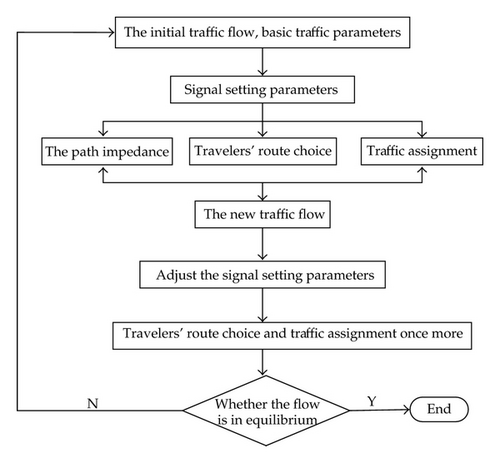
The process of algorithm analysis is showed in Figure 1, which is summarized as follows.
Step 1. Obtain the initial traffic flow information based on real-time detection.
Step 2. Determine a set of signal setting parameters based on the initial traffic flow.
Step 3. Adjust the impedance of each path in the road network by traffic control, thereby affecting travelers’ route choice.
Step 4. Calculate the flow after superimposed according to the travelers’ route choice and the initial traffic flow.
Step 5. Adjust the signal setting parameters and traffic assignment again.
Step 6. Through the system utility value, determine the equilibrium situation.
The second part of the algorithm is to decide the signal setting parameters in order to balance the traffic flow under the influence of travelers’ route rechoice. The main idea of this part is to determine the maximum green (gmax ) time or the minimum green time (gmin ) of each signal phase and then to extend or shorten the signal cycle (C) and green time (g) to ensure that the flow ratio (yi) and the split (λi) are approximately equal. The signal control method under the impact of changing flow is shown in Figure 2.
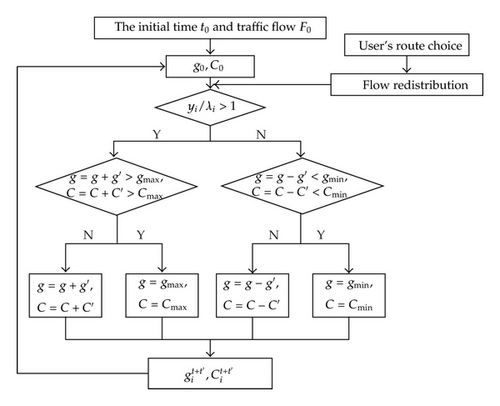
The process of algorithm analysis is shown in Figure 2, which is summarized as follows.
Step 1. Obtain the initial traffic flow information based on real-time detection.
Step 2. Calculate the initial signal cycle C0 and the initial green time g0 according to the following equation:
Step 3. Combined with the redistribution flow of road network to judge whether yi/λi is approximate to 1, we can calculate the yi/λi according to the following equation [20]:
Step 4. Determine the Cmax , Cmin , gmax , and gmin for Step 5 to determine the suitable C and g. Generally, the cycle and the green time should not increase too much or too little; for this part we determine the Cmax and Cmin based on the following equation:
Then we determine the gmax , gmin under the constraints of Cmax , Cmin ; the specific calculation method can be expressed as follows:
Step 5. Increase or reduce the signal cycle and green time according to traffic demand under the constrains of Cmax , Cmin .
Step 6. Feed back the determined signal cycle and green time to Step 2.
4. Algorithm Implementation
4.1. Supply and Demand Balance Analysis
When the relationship between supply and demand meets dd(t) < 0.95, traffic managers should shorten part of the signal cycle length in order to reduce the delay time. When the relationship between supply and demand meets 0.95 ≤ dd(t) < 1.05, we think that it is equilibrium of supply and demand. When the relationship between supply and demand meets dd(t) ≥ 1.05, traffic managers should adjust the signal setting parameters in order to change the relationship between supply and demand [21].
4.2. User’s Route Choice Model
4.3. Utility Functions Establishment
We can find that speed decreases with increasing flow in unsaturated and flow and speed decrease in saturated from speed-volume graph (Figure 3(a)); meanwhile, we also can find the maximum product of flow and speed from speed-volume graph (Figure 3(b)).
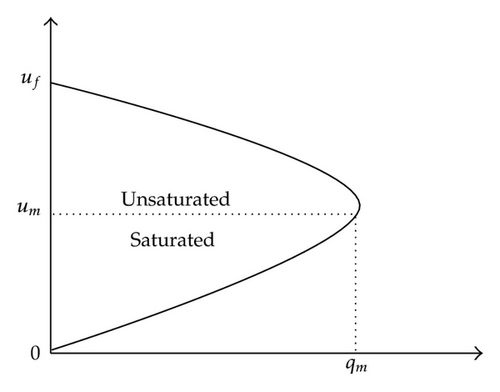

4.4. User’s Equilibrium Traffic Assignment Discriminant Model
5. Numerical Example
The test network is a simplified region of road network from Changchun city which consists of 12 links and 5 intersections. All links of the road network are bidirectional and of four lanes, and the initial data is obtained by manual collection. The number of links in the road network is shown in Figure 4(a), and the road link’ traffic flow is shown in Figure 4(b). The links length is shown in Table 1.
| Number | 1 | 2 | 3 | 4 | 5 | 6 | 7 | 8 | 9 | 10 | 11 | 12 |
| Length | 532 | 1118 | 1244 | 478 | 593 | 616 | 1494 | 1566 | 1609 | 1428 | 336 | 314 |
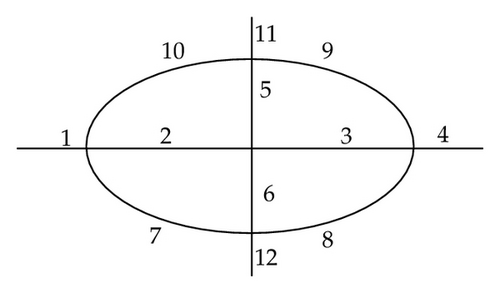
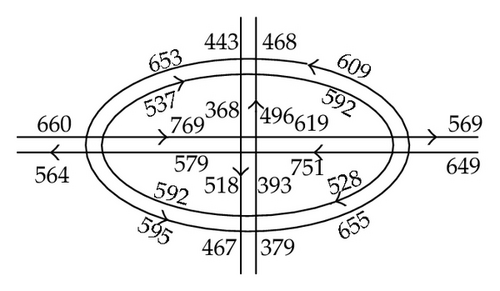
We can find four pairs of O-D which, respectively, belong to link 1, link 4, link 11, and link 12. This paper simulated a pair of O-D (from link 1 to link 4) to determine the equilibrium degree of road network and to verify the superiority of the coordination algorithm. There are seven paths from link 1 to link 4, that is, path A (1-2-3-4), path B (1-7-8-4), path C (1-7-6-3-4), path D (1-10-9-4), path E (1-10-5-3-4), path F (1-2-5-9-4), and path G (1-2-6-8-4). We can find that the shortest distance is the path 1-2-3-4, but there is a heavy traffic flow on link 2 and link 3.
In the simulation test process, we set the traffic signal based on Synchro Studio 7 which is a traffic signal design software; we also have embedded the above algorithms into the traffic signal design software. During the inflow increase from 1600 pcu/h to 4400 pcu/h, we first get the path impedance based on VISSIM traffic simulation software which is shown in Table 2.
| Volume (pcu/h) | Number | ||||||
|---|---|---|---|---|---|---|---|
| Path impedance after application of algorithm(s) | |||||||
| A | B | C | D | E | F | G | |
| 1600 | 315 | 311 | 340 | 334 | 387 | 352 | 368 |
| 2000 | 324 | 333 | 368 | 359 | 422 | 378 | 401 |
| 2400 | 356 | 359 | 391 | 385 | 451 | 405 | 425 |
| 2800 | 395 | 402 | 436 | 425 | 489 | 443 | 461 |
| 3200 | 431 | 426 | 473 | 447 | 536 | 479 | 508 |
| 3600 | 488 | 458 | 525 | 486 | 593 | 562 | 547 |
| 4000 | 609 | 551 | 646 | 588 | 704 | 625 | 652 |
| 4400 | 637 | 654 | 716 | 654 | 729 | 724 | 718 |
| A | B | C | D | E | F | G | |
|---|---|---|---|---|---|---|---|
| (pcu/h) | 581 | 538 | 493 | 526 | 507 | 497 | 486 |
| (km/h) | 26 | 31 | 35 | 29 | 37 | 35 | 33 |
| (s) | 467 | 472 | 449 | 503 | 416 | 446 | 470 |
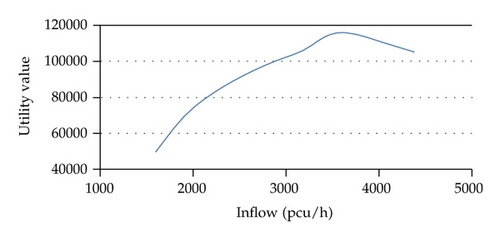
We next verify the superiority of the algorithm by inputting the initial data into the test network. During the simulation, we should mark all vehicles in order to record the different paths’ impedance and then obtain the average impedance of each path. The average impedance and the equilibrium degree are shown as follows.
As seen in Tables 4 and 5, the new algorithm achieved the equilibrium of road network and that could save 21 seconds for each vehicle from point 1 to point 4 in the test network. Although this test network demonstrates a better performance of the coordination algorithm, more extensive tests need to be performed to validate the algorithm, for the above test only simulated a pair of O-D and did not consider the impact of distance on the users’ route choice.
| A | B | C | D | E | F | G | |
|---|---|---|---|---|---|---|---|
| Paths impedance | 494 | 423 | 518 | 466 | 502 | 487 | 496 |
| Equilibrium degree(s) | 0.945126 | 1.117364 | 0.866541 | 1.07808 | 0.828577 | 0.914520 | 0.947947 |
| Average impedance(s) | 484 | ||||||
| A | B | C | D | E | F | G | |
|---|---|---|---|---|---|---|---|
| Paths impedance | 483 | 474 | 438 | 506 | 433 | 454 | 456 |
| Equilibrium degree(s) | 0.966650 | 0.997141 | 1.024814 | 0.992858 | 0.960614 | 0.980994 | 1.031100 |
| Average impedance(s) | 463 | ||||||
6. Conclusions
In this paper, we presented a traffic control algorithm considering traffic assignment of road network, which has been implemented successfully by introducing the link impedance function and the route choice function. In the process of optimizing the coordination algorithms, we also get the optimal flow of path, the optimal impedance, the maximum system utility value, and so forth. Finally, we verified the superiority of the coordination algorithm and the model through a numerical example based on the VISSIM software.
For further issues, we should introduce traffic guidance information into the coordination algorithm of traffic control and traffic assignment and then verify it by the road network with multiorigin and multidestination to be closer to the actual situation.
Acknowledgments
This work is partly supported by the National Science Foundation of China (Grant nos. 50908100, 51108208), China Postdoctoral Science Foundation funded Project (no. 20110491307), and the Fundamental Research Funds for the Central Universities (no. 201103146). The authors thank the anonymous reviewers for their valuable input and suggestions.




